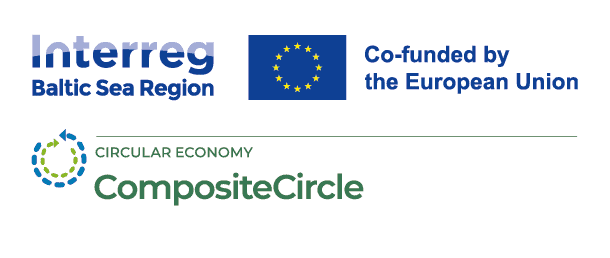
The journey towards ambitious goals is well underway
26 November 2025
Text: Pirjo Pietikäinen, Plastics Industry Federation of Finland
The recycling of composites is now more topical than ever, especially as the wind power industry and the manufacture of wind turbine blades are growing strongly. Finland has been active in initiating an international CompositeCircle, which is funded by the EU’s Interreg Baltic Sea Region programme. The three-year (2025-2028) project brings together experts from the wind power industry, composite products, waste management companies, the cement industry and the chemical sector from six Baltic Sea countries: Finland, Lithuania, Latvia, Poland, Denmark and Sweden. A total of 24 partner organisations are involved in the project.
The project is coordinated by Centria University of Applied Sciences as an expert in the recycling and circular economy of reinforced plastics. From Finland, Muovipoli Oy and the Finnish Plastics Industry Federation are also involved, whose task is to expand the domestic recycling ecosystem and export know-how to other Baltic Sea countries, as well as to bring international knowledge to Finnish industry. The total funding of the project is EUR 2.92 million, of which EUR 2.33 million is covered by the European Regional Development Fund (ERDF).
Unfortunately, it is no longer possible to join the CompositeCircle project as a partner, but those interested are welcome to join the mailing list and participate in information sharing as an associated partner. In this way, information about the project’s events and most significant achievements is shared already during the project. The project has aimed to organize four workshops to build a strong foundation for collaboration within the project and to raise awareness of the circular economy. These workshops help to create international value chains for composite material recycling, enabling the practical application of the knowledge, methods, and benefits gained from multiple countries.
First partner meeting in Lappeenranta
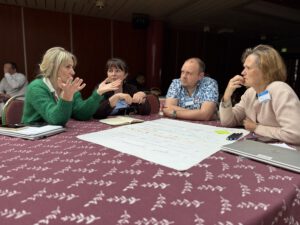
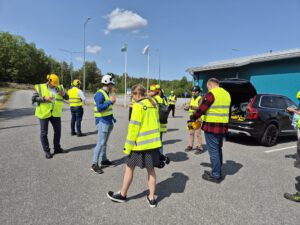
At the beginning of June 2025, the first partner meeting of the project was held in Lappeenranta. The city was not a random choice, as the meeting participants were able to visit Finnsementti Oy’s Lappeenranta factory, which is a key player in Finland in the utilisation of composite waste as energy and raw material in cement production. The meeting was attended by representatives of companies and research institutes, as well as authorities from different countries.
In Finland, the recycling of composites has been developed for years. The KiMuRa model operating here was presented to the project consortium, after which Sara Tikka from Kuusakoski Oy explained their role in KiMuRa recycling in more detail. In the Finnish model, Kuusakoski Oy collects and crushes reinforced plastic waste, which is used in the cement manufacturing process. Having a functioning organisation for the collection of composite waste that covers the whole country is key to ensuring that recycling works in the first place.
For most of seminar participants, a visit to Finnsementti Oy’s production plant was the highlight of the Lappeenranta Days. The meeting participants received a two-hour dose of information on how a cement factory works in general and in particular how composite waste is treated when it serves as a raw material for cement clinker (glass fibre reinforcement) and as a fuel for incineration (matrix). The visit also highlighted the fact that mutual understanding between the organisation collecting waste and the waste user plays a key role in the success of recycling.
During the seminar days, work was also done to identify the biggest challenges and best practices for achieving the goals set for the project. Of composite recycling technologies, the CompositeCircle project focuses on parallel processing and solvolysis.
The project’s work topics include:
- Determination of the number of existing wind turbines and practices related to their dismantling and possible recycling in the countries involved in the project
- Status of existing legislation concerning the composites industry in the countries involved in the project
- What are the economic and environmental impacts of recycling composite waste?
- Piloting the value chain to be developed.
Third and forth workshops
The third workshop was held in Krakow, Poland, where various chemical technologies applicable to the composite material recycling value chain were discussed in more detail. A key focus was to identify practical solutions for industrial implementation on an international scale. Several speakers were invited to present concrete solutions, and a discussion panel was organized.
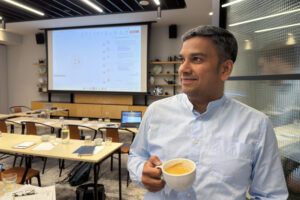
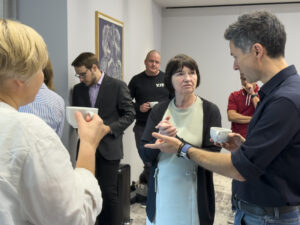
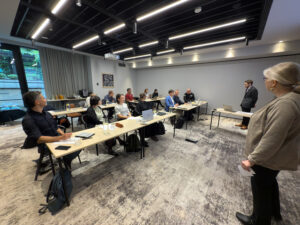
The discussions considered various perspectives, including how different types of composite materials can be chemically treated through solvolysis methods. End users have shown growing interest in recycled composite solutions, making it important to identify new ideas for composite end products and to find additional recycling options for the value chain.
The fourth workshop will be organized in Latvia at the end of January and will focus more closely on waste management topics, including composite waste handling, waste logistics, and different regulatory aspects. The event is currently being planned, with the goal of gathering a diverse group of speakers to share best practices in waste management, ensuring that the value chain becomes practical, functional, economical, and ecological. The event will be open to stakeholders, and participation is encouraged to bring new perspectives to the project.
New recycling solutions: solvolysis
The project will also evaluate new technologies for recycling reinforced plastics. One of the most promising is solvolysis based on chemical dissolution. The method distinguishes between fibres that can be used in the manufacture of new composites and resins that can be recycled again as adhesives or as replacements for virgin resins.

By combining the know-how and resources of the Baltic Sea Region, we are able to develop recycling solutions that are not only technically feasible, but also economically and environmentally sustainable. The goal is for composite waste to become a raw material to be utilised in the future instead of a problem,” says Project Manager Eemeli Seppänen from Centria University of Applied Sciences.
Should the Baltic Sea region become a pioneer in the recycling of composites?
In the CompositeCircle project, Finland serves as an example of how the logistics of recycling composites have been successfully organised nationwide. In Denmark, research has already been carried out on the use of solvolysis technology in the separation of reinforcement and resin and in the recycling of matrix resin.
As a result of the project, the aim is to create a functioning recycling ecosystem for reinforced plastics. With future needs in mind, a recycling guide and recommendations for companies and decision-makers will be prepared. The guide provides information for businesses and authorities to contribute to the development of regulations and recommendations for the management of GFRC waste.
As a result of the project, it is intended to achieve:
- Instructions for the collection, sorting and pre-treatment of composite waste
- Analysis of composite recycling techniques with a focus on co-processing and solvolysis
- Analysis of the environmental and economic impacts of composite recycling
- Agreements between actors in the value chain
- Recommendations to legislators
The aim of the three-year project is to create synchronized international industrial value chains for the recycling of glass fibre and carbon fibre composite products. The international approach is essential, as it brings together experts in the composites industry, which benefits both the industry and the implementation of sustainable development extensively.





